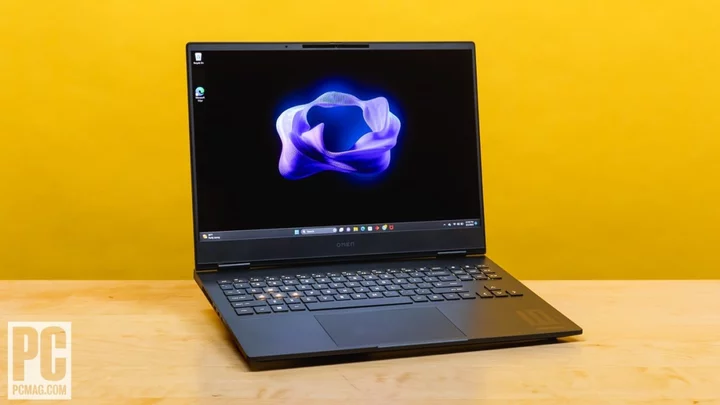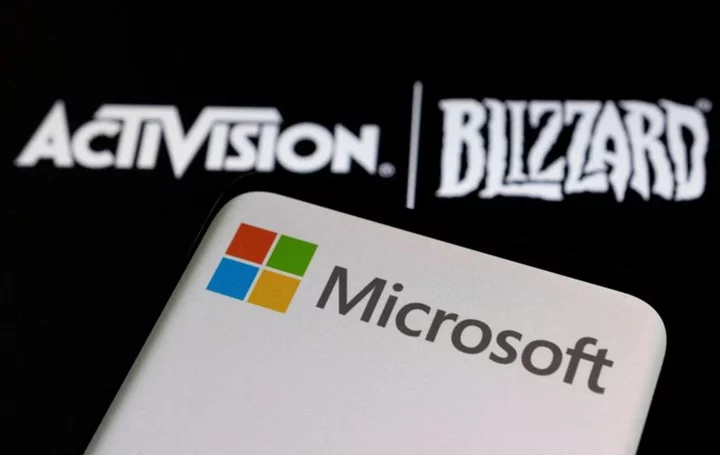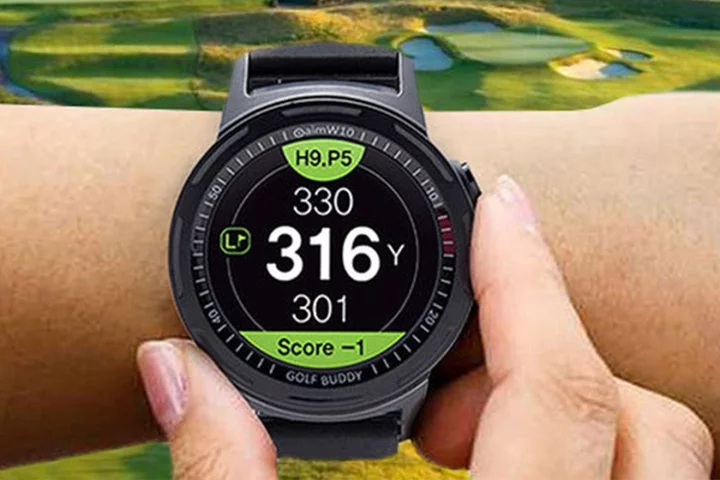A slimmer refinement of its Omen 16 gaming laptop, HP's Omen 16 Transcend (starts at $1,299.99; $2,959.99 as tested) has landed with a focus on form. After discontinuing the all-AMD HP Omen 16 (2022) in favor of its HP Omen 16 (2023) with 13th Gen Intel processors and Nvidia RTX 40 series graphics, HP has leveled up those designs in the Transcend. Bringing superior components into a sleeker, lighter package throttles some power, but HP introduced an ultra-bright (albeit ultra-pricey) 1600p, 240Hz mini LED screen as consolation. That said, the Editors' Choice-award-holding Lenovo Legion Pro 7i Gen 8 can either match or outclass HP's laptop for less cash, holding onto its title among high-end gaming laptops.
Design and Configurations: Cramming in the Power
Customized at checkout, our $2,959.99 Omen Transcend 16 review unit packed an Intel Core i9-13900HX CPU, an Nvidia GeForce RTX 4070 GPU tuned at 130 watts (130W) total graphics power (TGP), 32GB of memory, and a 2TB solid-state drive. HP also sells a pre-built Transcend 16 option with a Core i7-13700HX CPU, a GeForce RTX 4070 GPU, 16GB of RAM, a 1,920-by-1,200-pixel 240Hz display, and a 1TB SSD for $1,599.
The Omen Transcend 16 sacrifices some graphics power compared with the updated Omen 16 model, but it's a slightly smaller and more discreet gaming laptop. (Oddly, however, this model includes a slightly better Intel Core i9 HX chip versus the preceding Omen using a Core i7.) Realistically, though, the decreases in size and weight are subtle, and while it isn't an absolute behemoth to carry around, it's no small laptop. Still, compared with other 16-inch gaming laptops, the Omen Transcend 16 is on the smaller end of the spectrum.
Measuring 0.78 inch thick and weighing 4.6 pounds, the Transcend 16 is only 16% thinner and 14% lighter than the original Omen 16 model. It's the first in the line to feature a lightweight magnesium-aluminum alloy body. Despite this metal casing, the body retains a plastic-like feel that might disappoint considering the price. A new screen lid replaces the former model's diamond emblem with an elegant Omen logo in a gloss that contrasts with the matte surface. The Omen Transcend comes in two color options: Shadow Black or Ceramic White. HP aimed to create a covertly powerful gaming laptop with a professional appearance, and it succeeded.
(Credit: Joseph Maldonado)A prominent difference between the Omen 16 and Omen Transcend 16 lies in their chassis designs, notably the shift from a 16:9 aspect ratio to a 16:10 aspect ratio with the Transcend. The 16:10 form factor makes the Omen Transcend 16 squarer than the regular Omen 16; however, the two models maintain a commonality in their metal construction and textural quality. It's important to highlight that, despite the screens' different aspect ratios, the bezel along the lower edge of the Transcend's panel remains unchanged.
(Credit: Joseph Maldonado) (Credit: Joseph Maldonado)The port selection, mostly the same between the machines, was already commendable. You get two 5Gbps USB 3.1 Type-A ports, a pair of USB-C Thunderbolt 4 connectors, an HDMI 2.1 output, an RJ-45 Ethernet jack, and an audio jack. Some are strategically positioned on the laptop's rear edge: The power port, the HDMI 2.1, one USB-A port, and the Ethernet jack help you keep a more organized desktop through easier cable management.
(Credit: Joseph Maldonado)HP's enhanced hinge design, implemented in select models over the past year, also comes to the Transcend. The double hinges, positioned near the edges of the base, can tilt the screen back up to 180 degrees. This feature won't come into play all that often, but it's a neat trick.
The built-in speakers produce audio that's just adequate. They handle higher-pitched audio better, while the lower bass frequencies sound tinny at times. With that in mind, HP brags that the Transcend provides "seamless headset pairing" and an "ultra-low latency audio experience." Testing HP's claims, I tried a few different wireless headsets on the laptop, and I was impressed by the connection speed and the audio quality. More so than with most gaming laptops, a quality gaming headset comes highly recommended for the Transcend.
(Credit: Joseph Maldonado)While the laptop ran quietly enough during general use (such as web browsing and video streaming), gaming quickly brought up the cooling fan volume noticeably, competing with the audio. The culprit is this laptop's amped-up GPU. Nvidia recommends no more than 115 watts (115W) of power for mobile RTX 4070 GPUs, while HP has the Transcend running at 130W peak, driving extra visual performance but requiring more cooling in the process.
(Credit: Joseph Maldonado)The 2-megapixel 1080p webcam, increasingly common in laptops these days, is unchanged between the Omen Transcend 16 and its predecessor. However, the lackluster quality and chromatic aberration on such a small image sensor mean you probably won't be using it outside of video calls. (If you were hoping to live-stream your gameplay with this webcam, we'd say get a dedicated shooter.) The camera continues to feature a manual privacy shutter.
(Credit: Joseph Maldonado)HP's keyboard provides gentle cushioning to every keystroke, enabling a swift and easy-enough typing experience for most work. Regardless, serious gamers might want to consider a mechanical keyboard for intense gaming sessions.
The touchpad dimensions have expanded from 4.9 by 3.1 inches on the recent Omen 16 to 5.3 by 3.4 inches on the Omen Transcend 16. This larger surface area makes navigation easier when you don't have a mouse handy. However, it's worth noting that the pad's click actuation depth feels shallow.
Testing the HP Omen Transcend 16: Sleek, Slim, and a Little Sluggish by Comparison
Since HP dropped AMD chips from its Omen lineup earlier this year, the Omen Transcend 16 runs on Intel and Nvidia silicon, albeit with slightly less impressive graphics than its predecessor (but a technically better CPU). As mentioned, our test model had the maximum upgrade options for $2,959.99. HP also sells a pre-built Transcend 16 option packing an Intel Core i7-13700HX CPU, an Nvidia GeForce RTX 4070 GPU, 16GB of RAM, a 1,920-by-1,200-pixel 240Hz display, and a 1TB SSD for $1,599.
To gauge the Omen Transcend 16's performance chops, we collected four other high-end gaming laptops, laid out below...
Naturally, we included the HP Omen 16 we reviewed in July. Our review model featured the Intel Core i7-13700HX, accompanied by a formidable Nvidia GeForce RTX 4080, 32GB of RAM, and a 2TB SSD—all for a hefty $2,819.99 (a little less than our Transcend configuration).
Next up is the $1,799 MSI Raider GE68 HX, which has a slightly superior Core i9-13950HX processor, but a GeForce RTX 4060 GPU that's a little behind the rest here. Like the Omen Transcend, it came with 32GB of memory, but it had just a 1TB drive, versus the Transcend’s 2TB.
We also factored in the Lenovo Legion Pro 7i Gen 8, our most recent Editors' Choice award winner for high-end gaming laptops ($2,749 as tested). This Legion had the same CPU and 32GB of memory as the Transcend, but a superior GeForce RTX 4080 GPU and a smaller 1TB SSD.
Finally, to include a laptop with similar design considerations for light weight and extra thinness, we have the Alienware x16 R1 ($2,949.99 as tested), thinner than HP's machine at 0.73 inch. It had a slightly weaker Core i9-13900HK CPU but a much beefier RTX 4080, plus 32GB of RAM and a 1TB SSD.
Productivity and Content Creation Tests
We run the same general productivity benchmarks across both mobile and desktop systems. Our first test is UL's PCMark 10, which simulates a variety of real-world productivity and office workflows to measure overall system performance and also includes a storage subtest for the primary drive.
Our other three benchmarks focus on the CPU, using all available cores and threads, to rate a PC's suitability for processor-intensive workloads. Maxon's Cinebench R23 uses that company's Cinema 4D engine to render a complex scene, while Geekbench 5.4 Pro from Primate Labs simulates popular apps ranging from PDF rendering and speech recognition to machine learning. Finally, we use the open-source video transcoder HandBrake 1.4 to convert a 12-minute video clip from 4K to 1080p resolution (lower times are better).
While the Omen Transcend is certainly capable of running most office and content creation tasks, it came in last in our lineup in PCMark 10, with the next closest being the Omen 16. This was somewhat surprising given its superior Core i9 processor versus the Omen 16’s i7. Running PCMark's storage test, the Transcend didn't fare much better, coming in second to last, only beating the MSI Raider GE68.
With Cinebench, the Omen Transcend 16 came in last, falling just behind the Omen 16 again. Faring a little better in Geekbench, the Omen Transcend came in third, beating the Omen 16 and Alienware but falling behind the Lenovo Legion Pro 7i Gen 8 and MSI Raider. In a surprise placement, though, the Transcend landed right in the middle of the HandBrake test results, leaving the Omen 16 well behind. However, the Legion Pro 7i and MSI Raider models generally outperformed it.
Why was the Transcend lacking in so many matchups here? It likely has to do with the laptop's size: At just 0.78 inch thick, the Transcend is nearly the thinnest gaming laptop here. Naturally, this limits the amount and size of the cooling hardware that's able to fit inside, thus leading to power constraints and slower results in comparison.
Graphics and Gaming Tests
For gaming laptops and other mobile gaming hardware, we run both synthetic and real-world gaming benchmarks. The former includes two DirectX 12 gaming simulations from UL's 3DMark, Night Raid (more modest, suitable for systems with integrated graphics) and Time Spy (more demanding, suitable for gaming rigs with discrete GPUs). Then, we use the cross-platform GPU benchmark GFXBench 5, which primarily gauges OpenGL performance. These GFXBench tests are rendered offscreen to accommodate different native display resolutions; more frames per second (fps) means higher performance.
Our real-world gaming testing comes from the in-game benchmarks of F1 2021, Assassin's Creed Valhalla, and Rainbow Six Siege. These three games—all benchmarked at 1080p resolution—represent simulation, open-world action-adventure, and competitive/esports shooter games, respectively. Valhalla and Siege are run twice (Valhalla at Medium and Ultra quality, Siege at Low and Ultra quality), while F1 2021 is run once at Ultra quality settings and, for Nvidia GeForce RTX-based systems, a second time with Nvidia’s performance-boosting DLSS anti-aliasing turned on.
Seeing as this laptop's native screen resolution is at 1600p, which is increasingly becoming the norm at this tier, we ran the same tests at the higher resolution, as well, and discuss them below our charts.
Looking at the graphics benchmark results, the Omen Transcend simply lacked punch versus the competition—admittedly, most of which had RTX 4080 GPUs for the same price or less. On 3DMark Time Spy, the Transcend placed second to last, only beating the MSI Raider by a small margin. The Night Raid benchmark results proved no better: The Transcend was down at the bottom with the Alienware. Our GFXBench tests saw similar results, with the Transcend coming in last on the Aztec Ruins benchmark and second to last on Car Chase, narrowly beating the MSI Raider and falling far behind Legion Pro 7i.
The real-world gaming benchmark tests disappointed, too, with the Transcend coming in last on both F1 2021 runs. (At 1600p, the laptop scored 72fps with DLSS off and 94fps with DLSS on.) In Assassin's Creed Valhalla at Medium graphics settings, the Transcend tied for last with the similarly priced RTX 4060-based MSI Raider, and it produced 99fps at 1600p. Running the same test at Ultra settings gave a similar curve of results, but the Transcend barely managed to stay out of last place, beating the MSI Raider by just two frames. (It recorded 72fps at 1600p).
Finally, Rainbow Six Siege, our esports game test, ran at high frame rates, but the Omen Transcend's numbers were lackluster by comparison. The Transcend pulled up in last place at both the Low and Ultra graphics settings at 1080p; it pumped out 237fps and 144fps, respectively, at 1600p.
So, why did this shake out so poorly for the Transcend? A lot of it comes down to size, and its constraints on cooling and power. Regardless of the Transcend's RTX 4070 being tuned above its suggested 115W peak TGP rating (to 130W), it's also nearly the thinnest gaming laptop here. And while Dell crammed an RTX 4080 inside its even thinner Alienware unit, its proprietary cooling technology might have given it an edge. Inversely, the MSI laptop was not only much thicker at 1.1 inches (which means more room for cooling hardware inside), but its GPU was also tuned well above its suggested TGP.
It's important to note that, while the HP Omen Transcend 16 lagged in nearly every test by comparison to this lot, costing more than some gaming laptops with punchier GPUs, these results indicate that this laptop should play most of today's PC games just fine—even at its native resolution. Just not as well as the others listed here.
Battery and Display Tests
We test laptop battery life by playing a locally stored 720p video file with display brightness at 50% and audio volume at 100% until the system quits. We make sure the battery is fully charged before the test, with Wi-Fi and keyboard backlighting turned off.
Additionally, we use a Datacolor SpyderX Elite monitor calibration sensor and its Windows software to measure a laptop screen's color saturation—what percentage of the sRGB, Adobe RGB, and DCI-P3 color gamuts or palettes the panel can show—and its 50% and peak brightness in nits (candelas per square meter).
With the Transcend, HP increased battery capacity from 83 watt-hours (Whr) on the Omen 16 to 97Whr. Still, this didn't add much in unplugged longevity. The Transcend lasted only 12 minutes longer than the Omen 16’s time. As an extra test, we ran the laptop at the same settings except in the high-performance Windows mode in which we run all other benchmarks, to see how long it might last in the more intense scenarios it's capable of. That cut its time by almost two hours, to 5 hours and 19 minutes. While you should always try to plug in for gameplay, anyway, you might get caught short using this laptop for long sessions working away from an outlet. (And wasn't that part of the point of going so thin?)
One area in which the Transcend absolutely excelled was in panel color reproduction, covering the complete sRGB and DCI-P3 color gamuts while reaching 91% Adobe RGB coverage. While most of these laptops nailed the basic sRGB requirements, none but the Alienware came close to the Transcend's other numbers. Likewise, the display was brighter than the rest by a country mile—the power of mini LED.
(Credit: Joseph Maldonado)Verdict: A Mighty Display, But a Little Meek in Other Areas
No one doubts that HP makes a sincere effort with its gaming laptops, a category it has played in for less than a decade, and the back-to-back improvements made this year to the Omen 16 line have all been worthwhile. The mini LED screen in particular upgrades the visuals considerably, and the sleeker body design undoubtedly gives the Transcend a style edge—but neither of these things improves performance. And, as you'd expect, the mini LED option is only available in the highest-end configurations.
Altogether, the Omen Transcend 16 trailed in performance versus similarly priced laptops that were a bit thicker, not to mention one crucial even-thinner model. With that, we gave the HP Omen Transcend 16 the same score we gave its predecessor, and suggest the Alienware x16 R1 for a thin-and-light gaming laptop, or the Lenovo Legion Pro 7i Gen 8 for the best performance at 16 inches.









